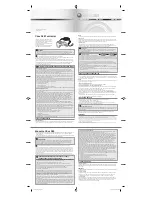
Curtis PMC 1209B/1221B/1221C/1231C Manual
16
from being brought into the operator compartment through the throttle micro-
switch, potentially exposing the operator to the high voltage source.
Forward/Reverse Wiring
The forward/reverse wiring schemes described here assume the power wiring
shown by the heavy lines in Figure 9. Some vehicles, especially those previously
using older, resistor-type controllers, may reverse the motor armature rather than
the
fi
eld winding. Be careful if you are replacing this type of controller.
When
using the Curtis PMC controller it is essential that the field be reversed and
that the armature be connected directly to the controller’s B+ and A2
terminals, because the plug diode inside is connected to these terminals.
Plug Braking
The standard forward/reverse control wiring (the thin lines in Figure 9) provides
plug braking. The forward/reverse switch should be in the positive feed to the
contactor coils, so that they can be turned off by the keyswitch, interlocks, and
throttle microswitch. The coil of one contactor or the other is energized to select
the direction desired. The contactor coils should have suppression diodes con-
nected across them to improve switch contact life.
This is the recommended wiring for controllers with the HPD option, in
applications where plug braking is desired. If your controller does not have the
HPD option, however, we recommend that you use the alternate wiring shown
in Figure 11 (and described below) instead of the standard wiring; this alternate
wiring will provide arcless contactor operation.
NOTE
: Plug braking is not recommended for on-road electric vehicles. The
plug braking feature is intended for material handling and low speed, low load
applications only.
Freewheeling: Wiring to Inhibit Plug Braking
If your controller has the HPD option, this feature can be used to inhibit plug
braking by brie
fl
y turning off the controller
’
s KSI input when the forward/reverse
switch goes through neutral. As shown in Figure 11, another set of contacts is
added on the forward/reverse switch. Therefore, a double-pole, double-throw
(DPDT) center-off switch must be used for this setup. A
“
hesitation switch
”
is
recommended, to ensure the switch is in neutral long enough to actuate HPD and
inhibit plug braking.
Plug braking can be reactivated during freewheeling by releasing the throttle
and reapplying it.
WIRING
















































